We may earn revenue from the products available on this page and participate in affiliate programs. Learn More ›
Shooting glasses do two main things for you. First, and maybe the most obvious, they protect your eyes from any debris or discharge that might occur while shooting. In case you haven’t heard(or seen), eyeballs are kind of important, especially when you enjoy shooting. Whether from spall flying off steel targets, ejected cartridge casings, gas blowback, or dirt and oil splatter, having a ballistically rated lens between your eyes and whatever is coming at them can make all the difference for a good day at the range.
Besides protecting your eyes, a good pair of shooting glasses can heighten your overall shooting experience. High-quality lenses give better clarity and when tinted with certain colors, give the shooter better contrast between light and dark for a faster pick up on sight picture and targets whether you’re shooting pistols or rifles.
I tested several different options to see which ones you’ll want to have whether you’re hunting, competing, or just plinking at the range. Throughout the process, I looked at safety ratings, clarity, comfort, price, and last but not least—style—to determine the best shooting glasses for a variety of applications.
How to Choose Shooting Glasses
Variations in personal comfort, locations, conditions, and prices play a huge role in determining the best shooting glasses for you. However, tested and proven ballistic ratings on whatever model you’re considering should trump all other considerations. Yes, even above style.
Expensive Doesn’t Necessarily Mean Safe
If the company you are considering doesn’t have their eyewear tested to some level of American (ANSI Z87.1(+), military (MIL-PRF-31013), or European (EN166) standard, you should consider alternate options. Each of those ratings include high impact tests that consist of high mass projectiles being dropped onto or shot at the lenses to test the overall durability, shatter resistance of the lens, robustness of the frame, and ability of the frame to retain the lens during the test. The tested rating is often marked on the inside of the frame or lens. Anything, even your best polarized sunglasses, that doesn’t have one these ratings probably won’t perform like the best shooting glasses.
Best Shooting Glasses: Reviews & Recommendations
Best Overall: Wiley X Saber Advanced
The best shooting glasses overall.
See It
Key Features
- Weight: 0.8 pounds
- Materials: Selenite polycarbonate lens, rubberized polycarbonate frames
- T-shell lens coating
- Compatible with PTX prescription insert
Pros
- Fully adjustable
- Secure fit
- Affordable price point for three-lens pack
Cons
- Arms can pop out if you adjust too fast
With a hard-to-beat price and comfortable, durable construction, the Wiley X Sabers were the best shooting glasses I tested. I first heard about Wiley X when I started working in the firearms industry about five years ago. After finally getting my hands on the Saber Advanced glasses, I was able to see what all the hype is about. I have a large head and found them to fit comfortably, especially with the adjustable nose piece and length adjustments on the arms. The thin, rubberized adjustable arms easily fit under earmuffs but don’t feel like they’re going to slide off my face.
When the arm fist popped out it caught me off guard, but when I watched this video from Wiley X, I discovered that the arms are intentionally easy to remove, which allows you to utilize the tactical strap that’s included with the glasses. Perhaps the best thing about these glasses is the price, especially since they include three interchangeable lenses. So, even if something happens to the first pair of lenses, you’re covered. These were the most comfortable glasses I tested, and their durable construction, clarity, and reasonable price made them a no-brainer for the top spot.
Best Budget: Radians Revelation
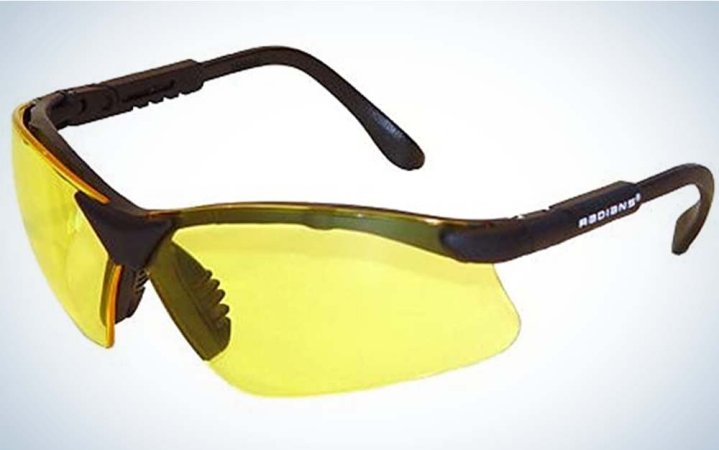
Feature packed shooting glasses with a budget friendly price.
See It
Key Features
- Weight: 0.140lbs
- Materials: Polycarbonate
- 99.9 percent UV protection
- Vent channel for fog control
Pros
- Inexpensive
- Fully Adjustable frame for a snug fit
- Vented frame to lens interface keeps fogging to a minimum
Cons
- Heavier overall weight
- Frame does not feel as robust when compared with higher dollar options
- Plenty clear for general shooting, but not the clearest on the market
I’ve introduced a few of my friends to shooting sports over the last few years, and many of them are instantly hooked. For those just getting started or on a budget, these glasses are hard to beat. Their adjustability allows them to fit just about any head size or shape, and they won’t break the bank for those new to sport. But, despite the incredible adjustability, I found the arm ends on the Revelations uncomfortable, even without ear muffs. And while these glasses are clear enough for shooting, they weren’t as clear as other options I tested. Still, if you want to protect your eyes on a budget, these are hard to beat.
Best Tactical: Oakley Ballistic M Frame 3.0
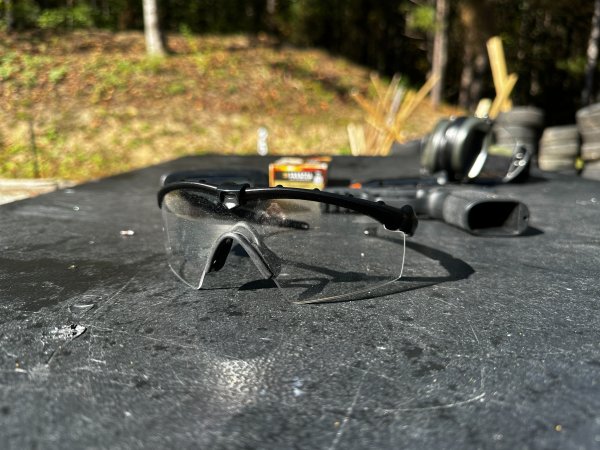
Photo by Scott Einsmann
Key Features
- Frame Width 145 mm
- Arm Length 135 mm
- surpasses ANSI Z87.1 Industrial Standards for high-mass and high-velocity impact protection
- Plutonite lenses
- Available in a variety of interchangeable lens colors
- Price: $175
Pros
- Comfortable with over ear protection and a hat
- Wrap around design helps protect eyes from hot gasses produced by shooting suppressed
- Secure fit
- Don’t impede peripheral vision
Cons
It doesn’t matter if you’re shredding targets at a USPSA match or plinking steel at the range, you need a good set of eye protection that won’t move when you do and won’t impede your vision. The Oakley Ballistic M frames are designed for that exact purpose. The arms are thin so that they won’t affect comfort or the seal of your over-ear protection. If you’re in the military or in law enforcement, they we designed to be comfortable while wearing a helmet, night vision, and comms.
If I’m shooting an AR it’s almost always suppressed. Even with a low-flow suppressor, that means I’m getting some gasses in my face and the M Frames’ tight fit does a great job of keeping my eyes from watering up. That tight fit means you get less air flow, which normally means fogging. Yet, I’ve worn mine in the humid Southeast all summer and the anti-fog coating worked tremendously. — Scott Einsmann
Best Prescription: Wiley X PEAK
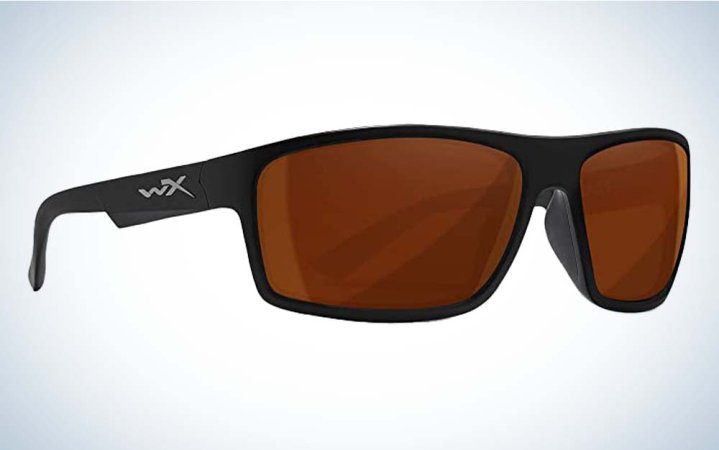
Premium lens with your own prescription.
See It
Key Features
- Weight: 0.06 pounds
- Materials: Polycarbonate
- 100 percent UVA/B protection
- Medium/large fit
Pros
- Lightweight
- Comfortable for all-day wear
- High-wrap frame gives full protection from sun and debris
- Prescription lens isn’t a separate insert
Cons
When it comes to their offerings for prescription shooting glasses, Wiley X takes an inter-pupillary distance measurement, as well as your prescription from your eye doctor, and grinds it into their safety rated, crystal clear lenses used in their other products. After testing the X Peaks, I now use them for everyday wear and eye protection at the range. The Captivate polarized lens coating on the PEAK glasses might come at a premium price, but they’ve quickly become my go-to choice of sunglasses. They fit perfectly for my head, and I often forget that I’m even wearing them. While I mainly wear contact lenses, I love these so much that I’m ordering prescription lenses from Wiley X for my own pair. To me, the cost is worth it, especially since you don’t have to install the prescription lens separately like their other models.
Best with Ear Muffs: ESS Crossbow Suppressor
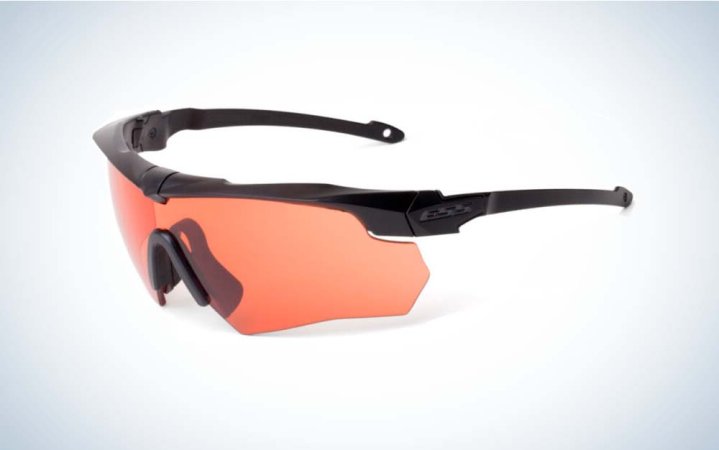
Full wrap-around protection with ear muff capability.
See It
Key Features
- Weight: 0.07 pounds
- Materials: Polycarbonate
- Z-Bend Geometry frame
Pros
- Ultra-thin arms create minimal interface between ear muffs and your face
- Can fit any ESS Crossbow lens
- Variety of lens color options
- Very lightweight
Cons
- Slick arms don’t feel as secure
- Lenses can be difficult to change
The Crossbow Suppressors offer full wraparound protection, with an ear muffs/comms compatible frame. The fact that ESS is owned and run by Oakley might not be the most well-known fact, but they’ve been making glasses with the sole intention of targeting the Mil, LE, and shooting sports world. I found the fit of the Crossbow Suppressors similar to the Oakley Ballistic M-Frames I’ve been using regularly at the range for the last three years. If you order the two frame package, only one of the frames has the ultrathin Suppressor arms, while the other frame has a more standard Crossbow frame. I had a tough time the first couple times changing the lenses, and they required a bit of force. But these frames can take a beating, and the fact that you can easily pair them with the best shooting ear protection makes them a convenient option.
Best for Trap and Sporting Clays: Wiley X WX Detection 5 Lens Package

A variety of lenses with excellent contrast.
See It
Key Features
- Weight: 0.06 pounds
- Materials: Polycarbonate
- Non polarized
Pros
- Huge sight picture
- Adjustable nose piece
- Extremely Lightweight
Cons
The WX Detection by Wiley X is a seriously ideal option for serious shooters, especially for sporting clays and skeet. The 5 lens kit comes with many options for all shooting disciplines, with the purple lens giving excellent contrast for the typically bright orange color of the clays. You know how you occasionally see pictures of Bono on the red carpet, and he’s wearing a tinted billboard-sized piece of glass on his face? Yeah, these kind of remind me of that, especially with the purple lens installed. However, the massive sight picture it provides when you’re looking for that small clay pigeon to come flying over your head is unparalleled. I don’t mind looking a bit like a goon if I can get a better visual on what I’m shooting. Besides you could wear these from the range to a World Premiere without skipping a beat.
Best for Indoor Ranges: Oakley Det Cord
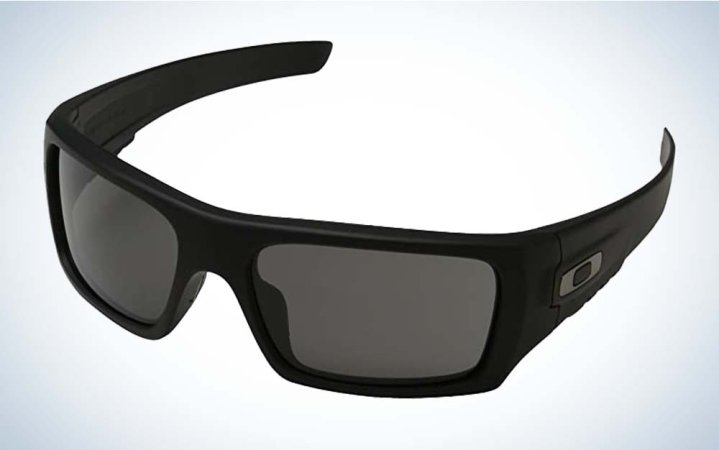
Wide-framed shooting glasses with excellent light transmission.
See It
Key Features
- Lightweight O Matter frame
- Materials: Polycarbonate frame, plutonite Lens
- MLI, ANSI compliant
Pros
- Full coverage frame
- Wide, but thin arms distribute pressure
- Allow for comfortable earmuff use
Cons
- Pricey
- Not made for easily interchangeable lenses
With the optimal light transmission and wide frame, the Oakley Det Cord, more specifically, the SI Ballistic Det Cord checks the box for the best indoor range shooting glasses. Even with the thick frames, the Det Cord glasses still give plenty of peripheral view, while the crystal clear lenses allow you to see the target at the other end of the range. And these are unmistakably Oakleys. The thick heavy looking, but lightweight frame and massive oblong “O” don’t just look awesome, but they provide full protection and excellent visual clarity, even when at my local, dimly lit indoor range. Despite the thick frames, I don’t feel like I have tunnel vision, even when I’m forced to shoot in a box.
Best for Casual Wear: Leupold Payload

See It
Key Features
- Materials: Polycarbonate lens, TR90-NZZ frames
- Polarized lenses
- ANSI Z87-2+ ballistic rating
Pros
- Can be worn on range, on the water, or at the beach
- Comfortable
Cons
- Don’t have the same performance as competitive shooting glasses
Maybe you’re looking for glasses that are well suited for the range, a fishing boat, and day-to-day casual wear? If that’s the case, Leupold’s Payload is worth considering. The glasses have an ANSI Z87-2+ ballistic and shatter proof lenses. Interestingly, Leupold says these glasses were made specifically for anglers with a polarization process that’s designed to prevent scratching and wear. I think the best thing about these shooting glasses is that they don’t look like shooting glasses. You might not win a gold in Olympic Skeet wearing them, but for a morning of casual plinking, they’ll work just fine. After all, the best eye protection is the one you’ve got with you, and these can be worn in casual settings every day.
I’ve worn a variety of Leupold glasses and they’re all comfortable. I personally like the Kati style the best, but that line doesn’t have the same ballistic rating as the Payload. So for use at range, I’d opt for these. —Alex Robinson
FAQs
The best prescription shooting glasses are options that include the prescription and protective rating in one lens. Wiley X PEAK and Aspect glasses are excellent examples of this, as they work with your prescription and a few other measurements to create a perfect lens fit for you.
Polarized glasses are good for hunting in many scenarios. While scouting on a bright day, or in abnormally glare-heavy conditions like snow, you want the best clarity. So when it comes time to make the shot, your eyes aren’t affected by the overall conditions. However, polarizing becomes more effective with darker lenses, and as the sun sets and animals get mobile, you might want to trade them for a clear option.
The best color lens for shooting glasses really depends on the conditions and applications. If you’re shooting indoors, clear is a solid option. But if you’re outdoors, vermillion, purple, and amber give high contrast between colors often associated with targets. During a bright day, a good smoke color brings the brights down and saves your eyes the strain. That’s why I prefer interchangeable lens systems that give me a minimum of three colors in that range.
How We Chose the Best Shooting Glasses
After getting my hands on as many of these as I could, I tested the best shooting glasses by wearing them during various outdoor activities for extended periods of time. I tested many of them during range days, horseback riding, driving, bicycling, and even building projects around the house. I looked at each pair for long term comfortability, clarity, and the amount of eye strain I felt after wearing them for extended lengths of time. After making notes about how these shooting glasses performed, I arrived at this list as the best options for the shooting range and beyond.
Final Thoughts
Any day you crack open the safe and grab your best rifles is a good day. But having the best shooting glasses to keep your eyes protected only makes it that much more enjoyable, and you’d be hard pressed to go wrong with any of these options.
Read the full article here
